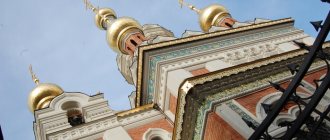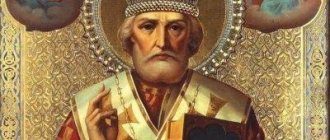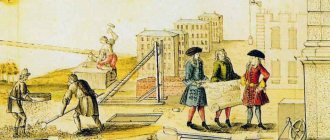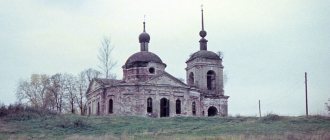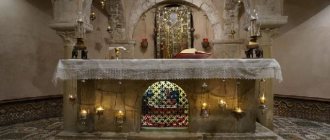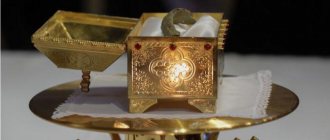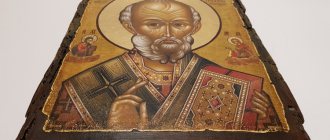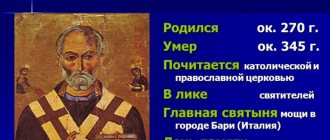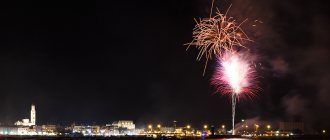The Cathedral of St. Nicholas the Wonderworker Evpatoria ranks second, after the Vladimir Cathedral in Chersonesos, in size in Crimea. It is also considered one of the most beautiful churches on the entire peninsula. Due to its height and impressive appearance, it is a real calling card of Evpatoria.
Photo of the cathedral:
Features of the Church of St. Nicholas the Wonderworker
It is interesting to note that in its architecture the cathedral resembles the famous Hagia Sophia in Istanbul. The base has the shape of an octagon, which is crowned by a dome made of concrete. The dimensions of the dome are impressive - its diameter is 18 meters. The cathedral can accommodate up to 2000 people at a time.
In total, there are 3 church altars in the temple: the main one, dedicated to Nicholas of Myra, on the right side is the throne of St. Alexander Nevsky, and on the left is the throne of James Zebedee. The inside of the cathedral is richly decorated with numerous paintings and frescoes.
Important information St. Nicholas Cathedral is a functioning church. When visiting it, you must comply with the appropriate clothing requirements and rules of behavior in religious sites.
About the cathedral
One of the most prominent buildings in Evpatoria is a remarkable architectural monument - the Orthodox St. Nicholas Cathedral, very impressive in size and majestic in outline, visibly towering above the surrounding urban development.
Painting - icon of St. Nicholas the Wonderworker, Archbishop of Myra in Lycia, above the entrance doors of the cathedral
The temple, without any doubt, is the main dominant feature of the historical part of Evpatoria, along with the Juma-Jami Mosque and the Church of St. Prophet Elijah, defines the architectural silhouette of the city from the sea. At the turn of the XIX-XX centuries. this building was perceived by residents and guests of the city as even more grandiose due to the fact that it was located mainly among one-story and very modest buildings. Only between it and the creation of Haji Sinan were two two-story European-type buildings from the mid-19th century. The main surroundings of the cathedral began to take shape after the completion of its construction and largely thanks to it.
Already in 1774, in Gezlev (the old name of Evpatoria) there was a small church of St. Nicholas, built by the Greeks living in the city. The church in the name of St. Nicholas was built by Anatolian and other Greeks at the end of the 18th century. Saint Nicholas is the patron saint of navigation and trade, and this gives the temple special significance in a seaside port city, which Evpatoria has always been.
In 1779, Gezlev escaped the plague thanks to the help of a military garrison under the command of A.V. Suvorov to the residents of the city. Alexander Vasilyevich Suvorov introduced strict quarantine measures in the city for all those entering the city and imported goods. A mandatory two-week quarantine was introduced for everyone. In addition, Russian soldiers repaired all the city baths, fountains and city wells. Local residents were ordered to whitewash their houses and yards with lime mortar, keep their toilets clean and wash themselves 5 times a day. Bathing in the city public baths became free and compulsory for soldiers and citizens. Suvorov visited the Church of St. Nicholas in Yevpatoria and sang with pleasure in the church choir. In 2004, next to the Cathedral of St. Nicholas, a monument to Alexander Vasilyevich Suvorov was erected on a stylized redoubt.
In 1805, a new church of St. Nicholas was built, but it was badly damaged during the occupation of Evpatoria during the Crimean War of 1853-1856, became dilapidated and involuntarily lost in the eyes of residents in front of the Khan’s and other mosques in the city.
By the beginning of the 90s of the 19th century, Orthodox Russians and Greeks made up almost half of the city's population and the need arose to build a new church.
His Eminence Innocent wrote in a report to the Holy Synod that in Crimea there are many Mohammedans whose ancestors were Christians.
In 1859, in response to the report of the Holy Synod with a petition for the opening of a diocese of the Russian Orthodox Church on the peninsula, Alexander II wrote: “So be it.”
The St. Nicholas Cathedral Church in Evpatoria was founded on July 11, 1893 (old style) in memory of the liberation of Evpatoria from the Anglo-French-Turkish troops by His Grace Martinian, Bishop of Simferopol and Tauride, together with the rector of the cathedral and priest Fyodor Turovsky in the presence of the dean of the parishes of the Evpatoria district Archpriest Iakov Chepurin. Priest Fyodor Turovsky became the rector of the cathedral.
Historians agree that the Orthodox church, without exaggeration, would not have been built without the tireless and energetic activity of Archpriest Iakov Chepurin , who was the soul of construction and who never lived to see the consecration of the cathedral (the church built with his zeal was solemnly illuminated on 16 February 1899 by His Eminence Nikon, Bishop of Volsky).
Due to intense pastoral labors and the hardships of life, Archpriest Chepurin died suddenly on November 29, 1898 and left this “world lying in evil” for the heavenly villages, where there is “neither sorrow nor sighing.” He was buried near the north side of the eastern apse of the cathedral.
Jacob Chepurin did not stop the construction of the temple for a minute, even when the funds at the disposal of the construction committee ran out: all his personal savings were used, family property and real estate were pledged. Four religious communities provided donations to Archpriest Jacob. The city treasury contributed, and Emperor Alexander III donated 36 thousand rubles for the good cause. The sudden death left the priest's family practically without a livelihood, which forced the city council to discuss several times the issue of providing assistance (payment of a pension or at least a one-time allowance) to the wife of the deceased. Taking into account his special merits in the construction of the temple, after its consecration, by decision of the general meeting, the name of Jacob Chepurin was assigned to one of the primary schools in the city.
The tireless work of Iakov Chepurin in the field of Christ was more than once awarded with church awards. On the 20th anniversary of his accession and rank, the Holy Synod bestows on the dean of the Evpatoria district the Golden Pectoral Cross (1880). the title of archpriest, and on the 25th anniversary of his pastoral service - a Cross with decoration, which was presented to him by the parishioners of the temple (1885). In 1891, Father Jacob received another award - for his work for the glory of the Church, he was awarded the Order of St. Anna, and in 1897 - the Order of St. Vladimir.
The church community petitioned the mayor to rename Museum Lane to Yakov Chepurin Lane.
On February 16, 1899, the St. Nicholas Cathedral Church was solemnly illuminated by Bishop Nikon of Volsky.
St. Nicholas Cathedral is an amazing monument of temple architecture. It is considered a similarity to Hagia Sophia in Constantinople. The huge dome of the cathedral, cut through at the base by window openings, and the side domes adjacent to the main building give it some resemblance to a temple erected in the capital of ancient Byzantium. But at its core, St. Nicholas Cathedral is a completely original work of a mature master.
The temple, without a doubt, is the dominant feature of the historical core of the modern city, defining the architectural silhouette of Evpatoria from the sea. Its artistic value is obvious. The Orthodox Cathedral for 2000 believers was designed by the famous architect Chairman of the Imperial Odessa Technical Society Alexander Iosifovich Bernardazzi. The architect's talent, embodied in his great creation, makes his name immortal.
The St. Nicholas Cathedral of the architect Bernardazzi is technically a very original and daring structure. When developing it, the master completely abandoned the traditional pylons that bear the main weight of the dome. The temple's plan is an octagon (octagon), covered with a huge monolithic concrete dome, 18 meters in diameter and weighing 156.6 tons.
It was made according to V.A.’s own precise calculations. Gerenek (the accuracy of the calculations is confirmed by the current state of the proven time, the past two World Wars and the Civil War - M.B.), who directly carried out engineering supervision over the progress of construction work, and is the most interesting feature of the building, an engineering innovation of that time. At the top of the drum, the number of faces doubles, each of which has a light window. Using concrete formwork, the edges of the drum are fused with the monolithic ceiling. Side domes adjacent to the main building. serve as a kind of buttresses, dampening the thrust of the main dome.
The square bell tower does not violate, but rather even emphasizes the overall compositional structure.
Having perfectly integrated his building into the landscape of the seashore, Bernardazzi made St. Nicholas Cathedral the organizing center of the entire architectural appearance of Evpatoria.
The initial sketches for painting the temple dome, vaults, walls, and faces of saints were made by teachers of the local men's gymnasium V.V. Sokolovsky and S.I. Stroev. The iconostasis was carved by the Florentine carver Vannuki. The bronze cross with gold and silver plating for the dome was cast by sculptor from Odessa B.V. Eduarde. A bronze chandelier with crystal decorations was donated by Odessa merchant I.I. For the sake of. Unfortunately, all these elements of the original design of the temple and the bell have not been preserved.
On May 16, 1916, the august family of the Russian Emperor Nicholas II and his family visited Yevpatoria. They were present in the Cathedral of St. Nicholas at a solemn prayer service for the longevity of the royal house and the Russian army. Her Majesty’s maid of honor Anna Vyrubova, who participated in this ceremony, recalled: “The meeting in Yevpatoria was one of the most beautiful. The entire area in front of the cathedral is one continuous carpet of roses. And all this is bathed in the southern sun.” It was the last Orthodox church, and Evpatoria was the last city in the Tauride province where Nicholas II set foot.
The temple has three altars: the central one is in the name of St. Nicholas of Myra, the miracle worker, patron of navigation and trade. On the right is the throne of St. Prince Alexander Nevsky, defender of the Russian land, on the sides of his face are depicted St. Princess Olga Equal to the Apostles and St. Prince Vladimir the Holy, who baptized Rus' at the end of the 10th century. On the left are the thrones of the Apostle Jacob Zvedeev and the Apostle Andrew the First-Called, whose sermons are associated with the spread of Christianity in Crimea and Scythia - Rus'.
The bell tower of St. Nicholas Cathedral has long since lost those first bells that rang during its consecration. Lost, broken, stolen. This is how we disposed of the inheritance left by our ancestors. Fourteen of the current bells were ordered and cast in Voronezh in 1990. The inscription was cast on the Voronezh bells of St. Nicholas Cathedral: “Sing joyfully to God, our Stronghold!” These words contain the essence of the soul and spirit of the people, their eternal faith.
After leaving the cathedral, do not rush to leave. Go to the temple courtyard. If you come from Tuchina Street, then, entering through the courtyard gate, you will see an old grave on the right. The Evpatoria doctor S.N. Auger, a Frenchman by origin, who in the 30s of the 19th century founded the first mud bath in the city of Saki and developed a mud therapy technique, is buried here. But let's move on. Also to your right is the grave of the founder of the cathedral, Jacob Chepurin. And on the left side, in the depths of the courtyard, there is another tombstone, on which is carved the inscription: Schema-nun Evgenia (Popova).
Mother Evgenia (Popova) is the mother of photographer and spiritual writer I.V. Popova - Permsky, who came with his family to Evpatoria in 1927 from Yalta after the Yalta earthquake. She was paralyzed. Having been widowed and having lost her priest husband, she accepted the great schema - the highest degree of monasticism. Schema-nun Evgenia was distinguished by deep faith and insight. People from all over Crimea came to the seer for spiritual advice and consolation. In 1934, schema. Evgenia went to the Lord.
The architect Bernardazzi made the Cathedral of St. Nicholas the organizing center of the entire architectural appearance of Yevpatoria and a decoration of the landscape of the seashore. Architecture is sometimes called history carved in stone. St. Nicholas Cathedral convincingly confirms the truth of these words. The breath of a bygone era emanates from the walls of the cathedral. Peering at the stone appearance of the temple, we can better imagine the people who created it.
The Cathedral of St. Nicholas the Wonderworker is located at st. Tuchina, 2.
In summer it is open for services and visits from 7.00 to 20.00.
Based on sources:
https://history-evpatoria.rf/religioznie-sooruzenija/svjato-nikolaevskij-sobor.php
https://www.evpatori.ru/svyato-nikolaevskij-sobor.html
https://omiliya.org/content/prichal-dlya-strazhdushchih-serdec
Historical reference
Since the 18th century, on the site of the modern cathedral, there has been an Orthodox church dedicated to St. Nicholas the Pleasant, the patron saint of all seafarers. During the Crimean War, the building was largely destroyed - the iconostasis was damaged, the church archive disappeared, and the bell tower was severely damaged. After the liberation of the city, it was decided to build a new temple dedicated to St. Nicholas the Pleasant.
The main inspirer and supporter of this large-scale project was Archpriest Yakov Chepurin. Under his leadership, fundraising began for the construction of the temple. Not only Orthodox parishioners, but also the Jewish, Armenian, Karaite, and Muslim communities of the city took an active part in it. Russian Emperor Alexander III himself donated a significant amount. However, even despite this, the money was not enough. Then Archpriest Chepurin pawned his family values and donated his income. Finally, two years later, in 1893, work began. The temple project was developed by the famous architect A.I. Bernadozzi. Construction of the cathedral continued until 1899. Finally, in February 1899, the temple was solemnly consecrated and services began there.
After the revolution, the cathedral was used as a granary, warehouse, and art workshop. In the early 1990s it was returned to the Orthodox Church.
Why is the cathedral interesting?
First of all, this is, of course, its majestic appearance. Many tourists are attracted by interesting facts. For example, local parishioners are confident: St. Nicholas the Wonderworker himself saved the shrine from an explosion by the German invaders.
In addition, on the territory of the temple, near the northern gate, the famous doctor N. Auger, the first to prove the benefits of the mud of Lake Saki, is buried. Of no less interest is the cross restored in the courtyard of the temple, on the site of that same Greek church.
Cathedral of St. Nicholas the Wonderworker
Looking for something to do in Evpatoria?
Entertainment
As for the interior decoration, on the walls you can see the paintings of the teachers of the local gymnasium of the century before last, V. Sokolovsky and S. Stroev. True, only their copies; the originals, unfortunately, have not survived.
At the same time, in my opinion, this place evokes special feelings, it is filled with positive energy. The crosses of St. George do not allow one to forget the events of the Crimean War, during which the religious building lost not only almost all of its valuable utensils, but even the bell tower. It would take a long time to describe the temple complex, but it is better to visit such objects on your own.
Cathedral of St. Nicholas the Wonderworker
Interesting facts about the temple
An interesting feature of this temple is the use of three types of crosses in its decoration. This:
- Traditional Russian Orthodox;
- Byzantine;
- Georgievskie.
The temple is located in the historical district of Yevpatoria. The city's central station is 2.2 km away. Nearby is another famous landmark of Evpatoria - the Juma-Jami Mosque.
St. Nicholas Cathedral is the main architectural dominant of the city. The temple is an outstanding architectural monument and is one of the historical heritage sites. It attracts many parishioners and tourists.
Address: st. Tuchina, 2, Evpatoria, Crimea.
Cathedral of St. Nicholas on the map of Crimea
GPS Coordinates: 5°11'48.0″N 33°22'45.0″E Latitude/Longitude
How to get to the Cathedral of St. Nicholas the Wonderworker
You can get here without any problems either on foot or by public transport. Get off at the “Pansionat Orbita” stop. By the way, there is a good Solaris beach nearby. In my opinion, it’s a good option to combine a cultural program with entertainment.
For those driving their own car, I recommend that you first acquire exact coordinates and follow them. A map with coordinates of the attraction is below . For travelers who left their car at home, but have not lost the desire to move around in comfort, I recommend considering the rental option. Believe me, it is very convenient and profitable.
Looking for a good beach in Evpatoria?
Here's a list for you
What to see
A distinctive feature of the temple is that it is decorated with 3 types of crosses at once: the church fence is complemented by St. George’s (they symbolize the valor and bravery of the soldiers of the Crimean War), the columns are Byzantine (these crosses emphasize the similarity of the Constantinople and Evpatoria churches), and the domes are traditional Russian Orthodox.
Near the northern entrance there is another small cross. The doctor N. Auger, who discovered the healing properties of Saki mud, is buried here.
The inside of the church is as majestic as the outside: magnificent frescoes, a huge number of windows and stained glass windows, a spacious prayer hall.
